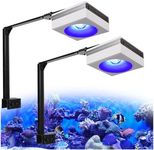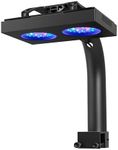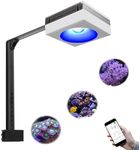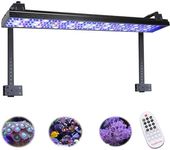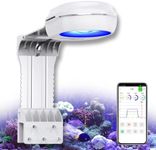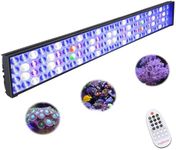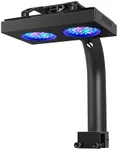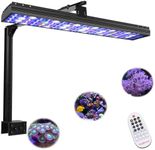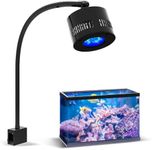Buying Guide for the Best Led Reef Light
Choosing the right LED reef light is crucial for maintaining a healthy and vibrant reef aquarium. The right lighting not only enhances the beauty of your aquarium but also supports the growth and health of corals and other marine life. When selecting an LED reef light, consider the specific needs of your aquarium inhabitants, the size of your tank, and your personal preferences for aesthetics and functionality. Understanding the key specifications will help you make an informed decision that aligns with your aquarium's requirements.Light SpectrumThe light spectrum refers to the range of colors emitted by the LED light. This is important because different corals and marine life require specific wavelengths for optimal growth and health. Most LED reef lights offer a full spectrum, which includes a range of colors from blue to red. Blue light is particularly important for coral growth as it penetrates water more effectively. When choosing a light spectrum, consider the types of corals you have. Soft corals may thrive under a broader spectrum, while SPS (Small Polyp Stony) corals often require more intense blue light. Look for lights that allow you to adjust the spectrum to suit the needs of your specific reef setup.
PAR (Photosynthetically Active Radiation)PAR measures the amount of light available for photosynthesis, which is crucial for coral health. It is important because it indicates how much usable light energy is reaching your corals. PAR values can vary widely, with higher values generally indicating more intense light. For most reef tanks, a PAR value between 100-300 is suitable, but this can vary depending on the depth of your tank and the types of corals you keep. If you have a deep tank or light-demanding corals like SPS, you may need a higher PAR. Consider your tank's depth and the light requirements of your corals when selecting a light with the appropriate PAR.
Coverage AreaCoverage area refers to the amount of space the light can effectively illuminate. This is important to ensure that all areas of your tank receive adequate lighting. LED reef lights come in various sizes and configurations, with some designed to cover small nano tanks and others suitable for large reef setups. To choose the right coverage area, measure the dimensions of your tank and ensure the light can cover the entire surface area. If you have a larger tank, you may need multiple lights or a light with a wider coverage area to ensure even distribution of light.
ControllabilityControllability refers to the ability to adjust the light settings, such as intensity, spectrum, and timing. This is important for simulating natural light cycles and optimizing conditions for coral growth. Many modern LED reef lights come with programmable features that allow you to customize the lighting schedule and intensity throughout the day. When choosing a light, consider how much control you want over these settings. If you prefer a hands-on approach, look for lights with advanced controllability options. If you prefer simplicity, a light with basic settings may be sufficient.
Build Quality and DurabilityBuild quality and durability refer to the construction and longevity of the LED light. This is important because reef lights are often exposed to moisture and heat, which can affect their lifespan. High-quality lights are typically made with durable materials and have features like waterproofing and efficient heat dissipation. When selecting a light, consider the environment it will be used in and look for features that enhance durability, such as corrosion-resistant materials and effective cooling systems. A well-built light will last longer and provide consistent performance over time.
